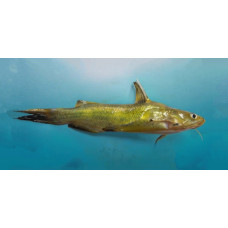Latin name
Tachysurus sinensis
Other name
Korean bullhead
Identification
The body of the Yellow catfish is elongated, lacks scales, and is covered in mucus. The head has four pairs of barbels. It possesses 33–40 vertebrae.
Features of Fish Fins
The dorsal fin has 1 spiny ray and 6–7 soft rays. The spiny ray is weakly serrated and slightly shorter than the pectoral spine. The pectoral spine features 7 to 33 serrations. The anal fin contains 16–27 soft rays. The adipose fin is longer than the dorsal fin.
Fish Coloration
The back of the Yellow catfish is greenish-black, while the sides and belly are yellow. Dark stripes and mottled patterns are clearly visible along the sides. Longitudinal stripes run along the upper and lower lobes of the caudal fin. Coloration intensity may vary depending on the habitat.
Distribution
This species is found in Laos, Vietnam, and all major rivers across China, primarily in their lowland sections. Within the Amur River basin, it occurs from the estuary to the lower reaches of the Onon River. High population densities are noted in the Lake Khanka basin. It also inhabits the Primorsky Krai region.
Habitat
It prefers rivers with slow currents and sandy or muddy bottoms. It also inhabits floodplain lakes with flowing water.
Size
The maximum recorded body length for this fish is 34.5 cm (13.6 inches). The maximum lifespan is 5 years.
Behavior
When caught and removed from the water, the Yellow catfish produces loud sounds—a "creaking" noise, which is the origin of its common name. When threatened, it erects its spiny rays to defend itself against predators.
Food and Feeding Habits
It is an omnivore. Its diet consists of aerial insects, benthic organisms, and small fish. Juveniles primarily feed on aerial insect larvae, mainly chironomids.
Reproduction
They reach sexual maturity at 3–4 years of age. Spawning occurs in summer, from June to late July. Spawning is batch-based. Males build nests by burrowing into the substrate, creating holes up to 16 cm (6.3 inches) deep. Typically, several nests are clustered together in one area of the river, forming a colony. Females lay between 2.3 to 11.5 thousand eggs. The eggs are yellow and measure 1.5–2 mm in diameter. Males guard the nest for up to 8 days.
Fishing
There is no significant commercial fishery for this species. However, it is one of the primary targets for recreational angling in the Amur River basin. The Yellow catfish is so abundant that smaller individuals often consume bait intended for other fish.
Relationship with Humans
The spiny rays pose a risk to anglers, as they can cause painful puncture wounds. The fish's body is covered in mucus, and a puncture can lead to skin inflammation or even infection. To handle the fish safely, anglers carefully hold it by the sides of the dorsal spine with two fingers. It is not advisable to discard the catch carelessly (e.g., on the bottom of a boat, especially if the angler is not wearing footwear). Before processing, the spines are typically clipped off with scissors or pliers. The Yellow catfish is not bony, and its meat is tender.
Interesting Facts
Yellow catfish live in colonies. There can be over twenty burrows per square meter, and the total area of a colony can sometimes reach several tens of hectares.
| Classification | |
| Phylum | Chordata |
| Class | Actinopterygii |
| Squad | Siluriformes |
| Family | Bagridae |
| Genus | Tachysurus |
| Species | T. sinensis |
| Features | |
| Conservation status | Least Concern |
| Habitat | Bottom |
| Life span, years | 5 |
| Maximum body weight, kg | No information |
| Maximum length, cm | 34,5 |
| Sailing speed, m/s | No information |
| Threat to people | Edible |
| Way of eating | Omnivore |
Yellow catfish
Tags: yellow catfish

